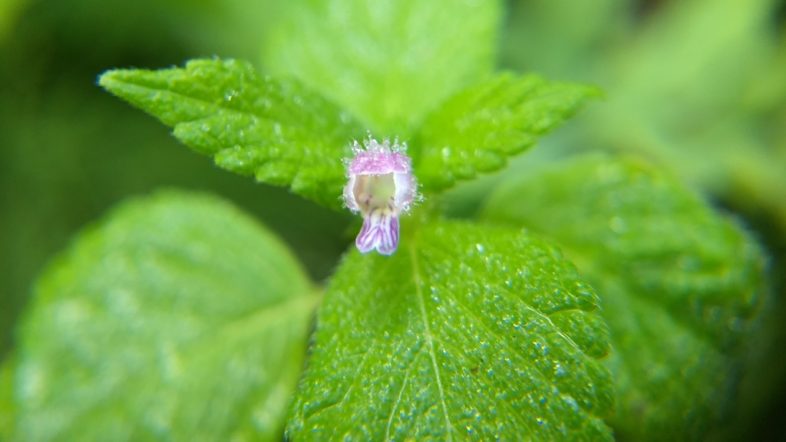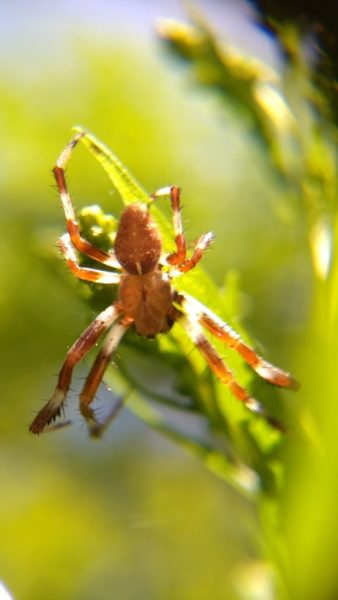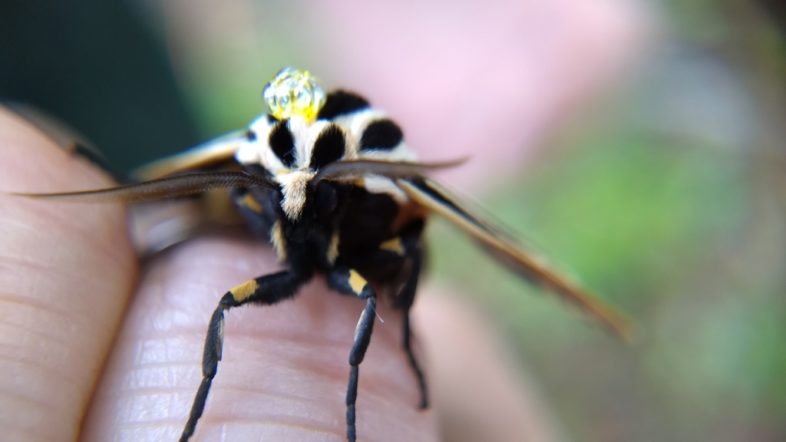With the advances in smartphone cameras, nearly everyone has a reasonable-quality camera on them at all times. Photos are a critical citizen science tool for documenting phenology and species presence, and the primary multimedia format submitted to iNaturalist Vermont, a project of the Vermont Atlas of Life. However, smartphone cameras are notoriously poor at taking close up photos, and most of us don’t walk around with a digital SLR camera complete with a macro lens. What’s an iNaturalist to do when she wants to photograph small flower parts, fern sori, or tiny insects?

Bifid Hemp Nettle (Galeopsis bifida) photo taken with a smartphone and an $18 clip-on macro lens, by Jason Hill.
Fortunately, clip-on macro lens for smartphones are an affordable, and surprisingly high-quality, solution. Clip-on macro lenses for smartphones look like a clothespin with a small camera lens mounted on one side–and yes, they are that easy to use. Macro lenses, for all models of smartphones, are widely available for less than $20. All of the photos in this post were taken with an $18 macro lens attached to a handheld Moto G5 Plus.
However, there are several considerations to make before purchasing a clip on macro lens.

A small orbweaver spider (Araneus spp.), taken with an $18 clip-on macro lens attached to Jason Hill’s smartphone.
- Is the lens compatible with your phone model? Some lenses only work with iPhones (where the camera is located near the edge of the phone), while other lens will work with all models. Carefully read the manufacturer’s description of the macro lens to ensure compatibility.
- Will it fit over my phone case? For the best photo quality, it is important that the macro lens sits correctly (flatly) over your phone camera. You may need to remove your phone case to achieve the best photos. This isn’t likely a big problem, unless you have a thick phone case, like an Otter Box.
- Will it allow me to take photos of what I want? Maybe. With a macro lens on your smartphone, you’ll have to be close (0.5 – 2.0 inches, depending on the magnification of the lens) to your subject to take a photo in focus. Any of the macro lens models available for your smartphone can help you take flora photos, but moving animals can be really challenging as they often flee from the camera as you move it in close. With a macro lens clipped onto your smartphone, your phone’s auto-focus will no longer function. Instead, you’ll have to manually focus the image by moving the phone closer to or away from the subject. In my experience, spiders and beetles generally sit still and tight for macro photos, but bumblebees, dragonflies and grasshoppers are difficult (but not impossible) to photograph.
Keep in mind that shooting with a macro lens requires a steady hand or tripod for clear and crisp photos–but it’s a game-changer. Curious, about the blob of liquid dispensing from the Virgin Tiger Moth in the photo below? Read more about that liquid here. If you have experience with one of these lenses, add your comments to this post to help others select one for themselves.

Virgin Tiger Moth (Grammia virgo), taken by Jason Hill with a smartphone and an $18 clip-on macro lens.

Not knowing anything about these lenses, I purchased the Akinger 18x macro lens clip. The lens is bigger than I anticipated, but that allows more light to come in (I suppose). With my Motorola phone, the camera is in the middle (away from the edge). So I needed a macro lens with a long clip–and this lens works very well on my phone.
Mine isn’t nearly as nice and magnify as much as your’s Jason, but I keep one of these macro bands in my wallet to use whenever I need it. https://www.easy-macro.com/. Here’s a tiny snail I photographed with it in my yard – http://www.inaturalist.org/observations/7433665
Is there any such solution for those of us with a digital camera without a macro?
Yes! Do you have a telephoto lens Libby? It won’t give you true (1:1) macro lens photos (so your photos won’t be as magnified compared to a true macro lens), but a telephoto will still give you ‘close-up’ photos and it will allow you to be much further away (1 meter or more) from your subject.
If you have a digital SLR camera, then you could try an extension tube. You can buy an intro model for <$30 for use with a >50 mm lens. If you have a digital point-and-shoot camera, many of them have a pretty good macro setting (the icon is usually a flower in your settings) as well.